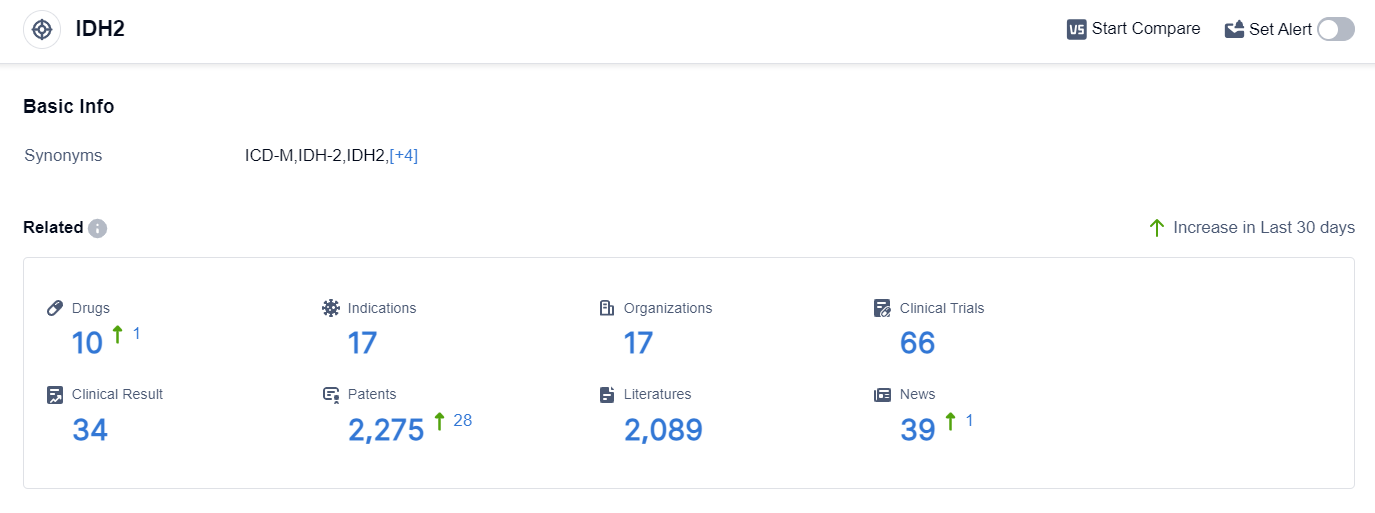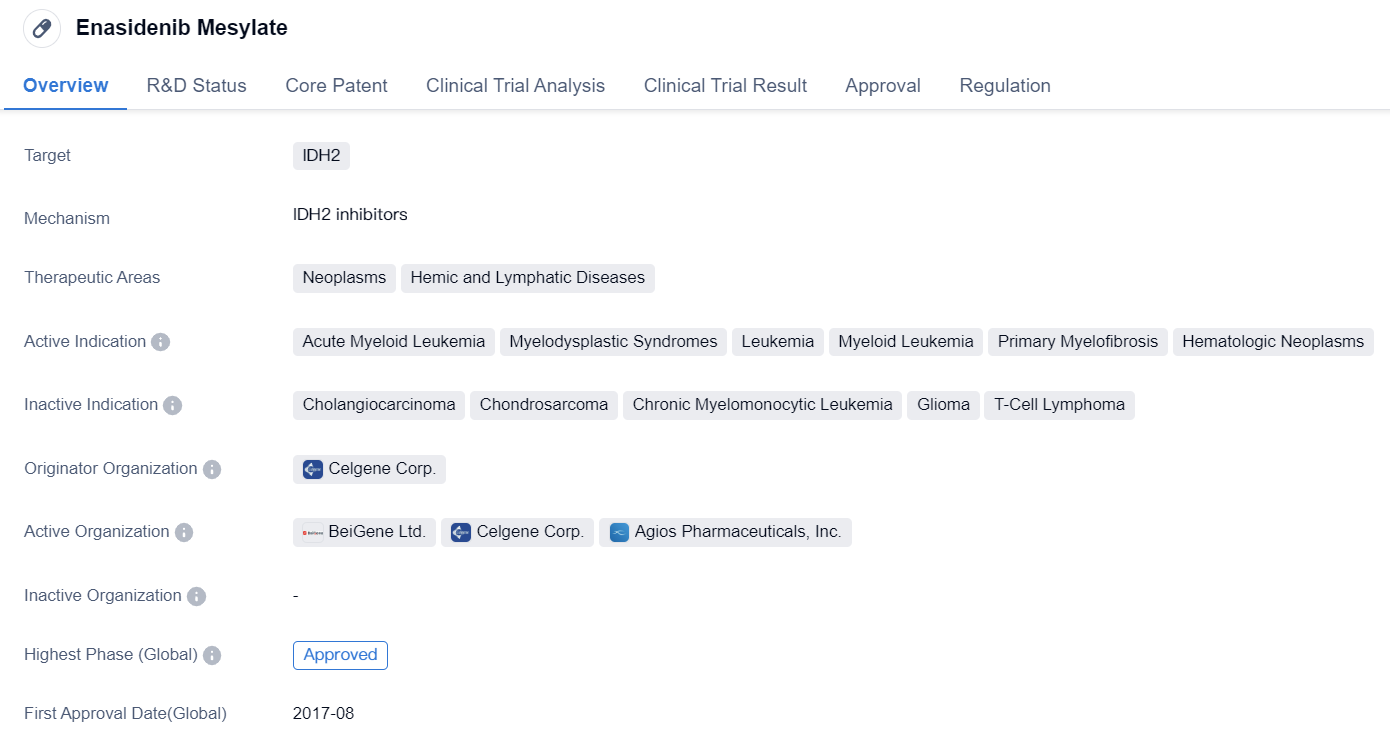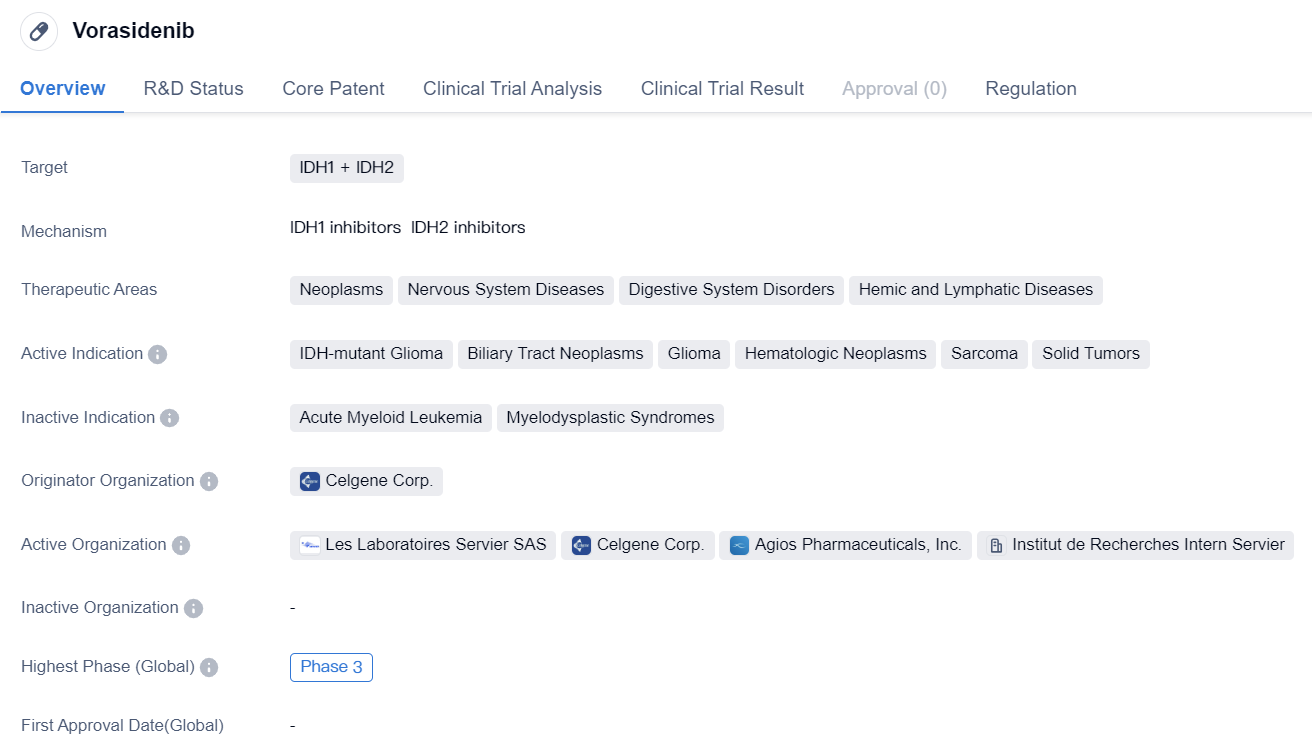Progress and Challenges in Targeted Cancer Metabolic Drugs - IDH2 inhibitors
IDH2, or isocitrate dehydrogenase 2, is an enzyme that plays a crucial role in cellular metabolism. It is primarily found in the mitochondria, the powerhouse of the cell. IDH2 is involved in the citric acid cycle, a key metabolic pathway that generates energy in the form of ATP. Additionally, IDH2 is responsible for the conversion of isocitrate to alpha-ketoglutarate, an important step in the production of cellular building blocks. Mutations in the IDH2 gene have been linked to various diseases, including cancer. Understanding the role of IDH2 in the human body is essential for developing targeted therapies and improving patient outcomes.
IDH2 Competitive Landscape
According to the data provided by Patsnap Synapse-Global Drug Intelligence Database: the following figure shows that as of 20 Sep 2023, there are a total of 10 IDH2 drugs worldwide, from 17 organizations, covering 17 indications, and conducting 66 clinical trials.
👇Please click on the picture link below for free registration or login directly if you have freemium accounts, you can browse the latest research progress on drugs , indications, organizations, clinical trials, clinical results, and drug patents related to this target.
The analysis of the current competitive landscape of target IDH2 reveals that Bristol Myers Squibb Co., Agios Pharmaceuticals, Inc., and Les Laboratoires Servier SAS are the leading companies in terms of R&D progress. These companies have drugs in advanced stages of development, including approved and Phase 3 drugs.
The indications targeted by these drugs include various types of leukemia, neoplasms, and solid tumors. Small molecule drugs are the most rapidly progressing drug type under the target IDH2.
The development of drugs targeting IDH2 is taking place in multiple countries, with the United States, European Union, and China being the key locations. China has shown progress in the development of drugs targeting IDH2, with drugs in Phase 3 and preclinical stages. Overall, the future development of target IDH2 holds promise, with ongoing research and development efforts by multiple companies and countries.
The current only approved marketed IDH2 inhibitors: Enasidenib Mesylate
Enasidenib Mesylate is a small molecule drug that targets IDH2, an enzyme involved in cellular metabolism. It is primarily used in the treatment of various neoplasms and hemic and lymphatic diseases. The active indications for Enasidenib Mesylate include acute myeloid leukemia (AML), myelodysplastic syndromes (MDS), leukemia, myeloid leukemia, primary myelofibrosis, and hematologic neoplasms.
👇Please click on the image below to directly access the latest data (R&D Status | Core Patent | Clinical Trial | Approval status in Global countries) of this drug.
The drug was developed by Celgene Corp., a pharmaceutical company known for its focus on innovative therapies in the field of biomedicine. Enasidenib Mesylate has reached the highest phase of development, which is approval, globally. It received its first approval in the United States in August 2017, making it available for use in clinical settings.
In China, Enasidenib Mesylate is currently in phase 3 of development, indicating that it is undergoing advanced clinical trials to assess its safety and efficacy in the Chinese population. This suggests that the drug may soon be available for use in China, pending successful completion of the phase 3 trials.
Enasidenib Mesylate has been granted several regulatory designations, including "Overseas New Drugs Urgently Needed in Clinical Settings," "Fast Track," and "Orphan Drug." These designations highlight the potential importance and urgency of the drug in addressing unmet medical needs, as well as the recognition of its potential to provide significant benefits to patients.
Overall, Enasidenib Mesylate is a promising small molecule drug that specifically targets IDH2 and shows potential in the treatment of various neoplasms and hemic and lymphatic diseases. Its approval in the United States and ongoing phase 3 trials in China indicate its progress towards becoming a globally available treatment option. The regulatory designations it has received further emphasize its potential impact in addressing critical medical needs.
IDH2 inhibitors entering Phase III clinical trials: Vorasidenib
Vorasidenib is a small molecule drug that targets both IDH1 and IDH2 enzymes. It is being developed for the treatment of various neoplasms, nervous system diseases, digestive system disorders, and hemic and lymphatic diseases. The drug is specifically indicated for IDH-mutant glioma, biliary tract neoplasms, glioma, hematologic neoplasms, sarcoma, and solid tumors.
👇Please click on the image below to directly access the latest data (R&D Status | Core Patent | Clinical Trial | Approval status in Global countries) of this drug.
Vorasidenib is being developed by Celgene Corp., a pharmaceutical company specializing in the development of innovative therapies. The drug has reached Phase 3 of clinical development. This indicates that it has undergone extensive testing in preclinical and clinical studies to evaluate its safety and efficacy.
In terms of regulatory status, Vorasidenib has been granted Fast Track designation and Orphan Drug status. Fast Track designation is given by regulatory authorities to expedite the development and review of drugs that address unmet medical needs. Orphan Drug status is granted to drugs that are intended to treat rare diseases or conditions.
The specific mechanism of action of Vorasidenib in targeting IDH1 and IDH2 enzymes is not provided in the given information. However, targeting these enzymes is of particular interest in the field of biomedicine as they are frequently mutated in various cancers, including gliomas and hematologic neoplasms. Mutations in IDH1 and IDH2 enzymes lead to the production of an oncometabolite called 2-hydroxyglutarate (2-HG), which contributes to tumor growth and progression. By inhibiting these enzymes, Vorasidenib may potentially disrupt the production of 2-HG and inhibit tumor growth.
In summary, Vorasidenib is a small molecule drug being developed by Celgene Corp. It targets IDH1 and IDH2 enzymes and is indicated for the treatment of various neoplasms, nervous system diseases, digestive system disorders, and hemic and lymphatic diseases. The drug has reached Phase 3 of clinical development and has been granted Fast Track and Orphan Drug designations. Further research and clinical trials are needed to determine the safety and efficacy of Vorasidenib in treating the indicated conditions.






